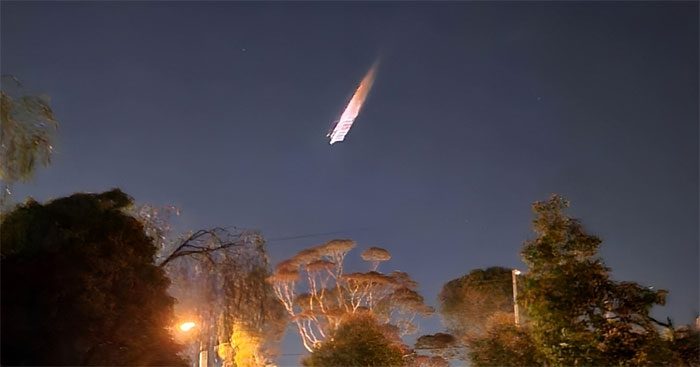The bright fireball and the supersonic boom that shook the state of Victoria, Australia on August 7, might just be a piece of rocket debris from Russia’s satellite launch on the same day, safely descending into the ocean.
According to 7 News Australia, the fireball appeared on August 7, providing stunning visuals for residents in Melbourne, the capital of Victoria, and other areas of the state.
Initial reports suggested it could be a strange meteor. However, scientists have determined that it was a piece of space junk, according to the publication Space.

Mysterious fireball over Melbourne city – (Photo: TWITTER).
According to astrophysicist and satellite tracking expert Jonathan McDowell from the Harvard-Smithsonian Center for Astrophysics (USA), it was the third stage of the Soyuz-2 rocket, which had been launched a few hours earlier by the Russian space agency, Roscosmos, from the Plesetsk Cosmodrome in the northwest of the country.
This rocket was tasked with launching the GLONASS-K2 satellite into space.
Dr. McDowell calculated that this piece would re-enter Earth’s atmosphere in the southeastern region of Tasmania, over a wide area of open ocean after launch. On its journey, it lit up the Australian sky.
It was simply a piece of space debris, as the main part of the rocket continued its proper trajectory to deliver the satellite into orbit.
During satellite or spacecraft launches, unnecessary parts of the rocket separate during the flight to reduce the overall weight of the system. The detached parts fall back to Earth, mostly burning up in the atmosphere due to the intense friction generated by the rapid descent.
According to Science Alert, this very process creates a remarkable brightness for the space debris as it travels across the sky. As it moves through the thin atmosphere of the planet, it can fall at speeds of at least 25,000 km/h.
Most of the unburnt parts are pre-determined by space agencies to land in uninhabited areas, often over clear ocean regions.
Therefore, while creating a fireball and a loud bang, it posed no danger to the people of Australia or anywhere else.
“Space debris is sometimes confused with meteors, which are also spectacular but typically much shorter events, as they enter the atmosphere at much higher speeds,” explained Associate Professor Michael Brown from the School of Astrophysics at Monash University (Melbourne, Australia).


















































